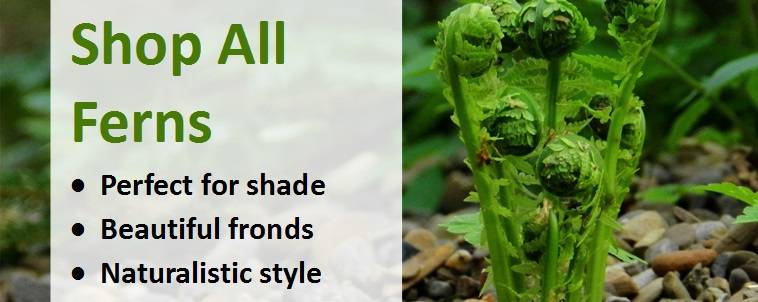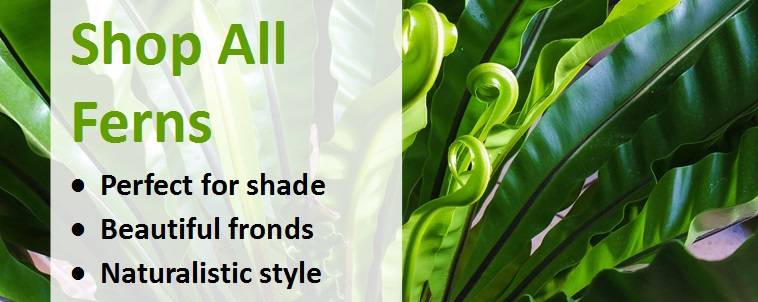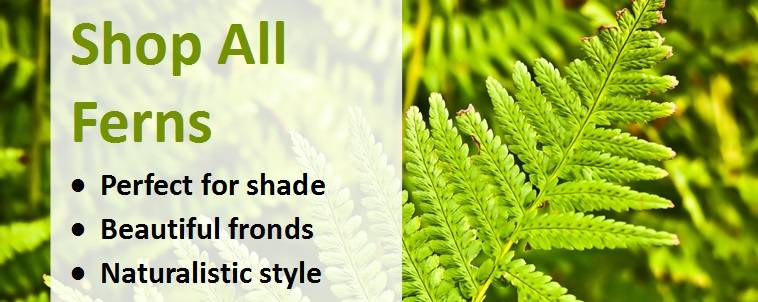Guide to Garden Ferns
Ferns are fascinating, highly versatile, ancient forms of plant life dating back to the Carboniferous period. Preceding flowering plants, they have been growing essentially unchanged for 360 million years. The family organisation of ferns has been substantially modified in recent years, and is still not clear, but don't be put off if you feel flummoxed by their unpronounceable, intimidating Latin names - ferns are magical, undemanding, shade loving plants which will thrive where little else grows. The intricacies of their leaf forms are substantially unchanged with new leaves starting out as tightly rolled, mysterious crozier or fiddleheads, gradually expanding by the unrolling of the tight spiral before erupting into marvellous fronds. Each frond has an intricate, delicately divided, architectural pinnate leaf form with fine hairs on the leaf margins, which can be crinkled and papery, graceful and feathery or bold and architectural. It is a thrill to watch the fronds unfurl into colours ranging from classic green to silver and bronze, knowing that you're seeing the same feat of nature that a slightly observant dinosaur would have witnessed millions of years ago.
Ferns vary enormously in shape and habit, from the stately, statuesque tree fern Dicksonia Antarctica which will slowly climb its way to between 4 and 8 metres (13 to 26 feet), to the tiny Dryopteris Cristata which seldom reaches a height of more than 30cm (12 inches). Some varieties die back completely following the winter cold, before bursting back into life again at the first sign of spring, whilst others are evergreen, staying green all winter and replacing old fronds with fresh new ones in the spring. As perennials, ferns will develop into bushy clumps with fronds of great beauty with time. Whilst commonly thought of as being shady woodland plants only, ferns also grown up tropical trees as epiphytes and also frequent both crevices in rock faces (generally sheltered from the full sun) and acid wetlands including bogs and swamps. With neither seeds nor flowers, they reproduce via spores and have a number of uses in the garden.
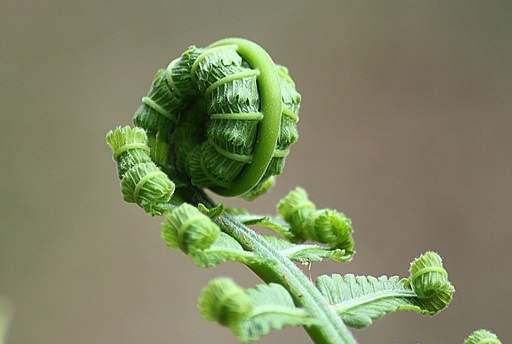
Uses
Ferns were extremely popular in Victoria times, but then fell out of favour until the resurgence of the majestic tree fern Dicksonia Antarctica, thought to be one of the oldest plants in the world, brought them back to our attention. As highly desirable plants, tree ferns are extremely slow growing, typically increasing by only 2.5cm (1 inch) per year; consequently, if you want a plant for immediate effect, you should choose a tree fern with a length of trunk that suits your planting scheme. Ferns can be used to add informality and splendour to shaded beds and borders, particularly for their intricate, architectural foliage which adds movement to your garden as it gently rustles in the wind. They are notably one of the staple garden plants of woodland gardens, often working most effectively when planted in groups, perhaps with a clambering variegated evergreen climber such as Hedera dentata Variegata or Hedera Goldheart scrambling in-between. Providing a unique, fresh, primeval feel, there is no finer sight that the light shining through the rich green plumes of Blechnum Spicant.
Ferns are also invaluable alongside water features, next to ponds or cascaded down ravine gardens, with some varieties coping with waterlogged spots where even bog plants struggle. Osmunda Regalis, for example, is perfect for growing as a marginal plant around a pond or stream. As one of our grandest native ferns, it has an upright, erect, clump-forming habit with reddish-brown fiddleheads, gradually unfurling to fresh, bright green, lacy-textured, lance-shaped foliage which tapers towards the tip. As a deciduous variety, its adds further colour and interest by turning butter-yellow, then russet in autumn. Give it plenty of room to develop and do not cut the dishevelled leaves down until the end of winter.

Fern plants really come into their own in dark, dank and apparently inhospitable parts of the garden. The smaller, hardy, shade loving plants such as Blechnum Spicant, Dryopteris Erythrosora and Polystichum Plumosum will succeed in those shady corners where little else thrives. It is noteworthy that they grow best in dappled or dense shade, rather than complete darkness, but many gardeners succeed in using them as a last resort for the most dingy places, providing they have their preferred moist but well drained soil. Last, but not least, ferns provide a graceful backdrop for showier plants, making them good neighbours for star performers, such as small flowering, berrying or fruit producing shrubs. They are tolerant of some degree of sun, making they a good choice as mid-level plants positioned between larger shrubs/trees and showier, small, front-of-the-border plants in deep, backwardly extending borders. The yellowing of fronds is a sign that ferns are getting a bit too much sun and ideally require some extra coverage.
Garden Care
Planting
Ferns are easy to grow, not susceptible to any common pests or diseases and generally unfussy, requiring no or very little care and attention once established. As mentioned, they are shade loving plants, growing best in dappled or dense shade rather than complete darkness and generally preferring a humus-rich, moist but free draining soil. Some grow best in a slight acidic soil, whilst others prefer a slightly alkaline soil, although non-ideal conditions are seldom a problem given their easygoing requirements. If you have a heavier clay soil, building in some organic matter when planting will do the trick. Plant at the same level as your fern was in the container when supplied, incorporating bone meal and organic matter such as leaf mould, garden compost or bark into the hole when you plant (try to avoid peat) and mulching generously once in the ground.
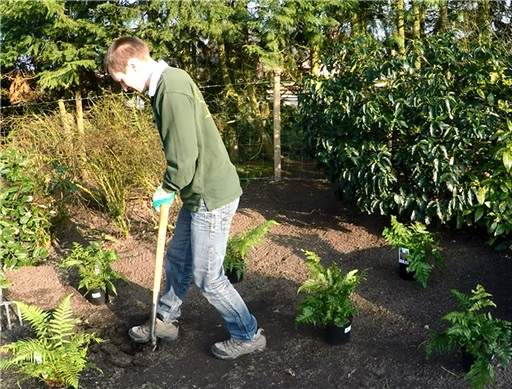
For tree ferns, plant just enough of the trunk to ensure that the plant remains stable (airing on the side of caution by planting slightly deeper if you are unsure) and use a mix of three parts multi-purpose compost, one part loam and one part sharp sand if container growing. Most ferns do best in a site out of too much wind, so try to provide some degree of shelter wherever possible.
Watering & Feeding
Ferns have fibrous roots, rather than deep woody taproots like roses, making them less able to access deeper water stores in the soil. As no fern likes to dry out completely, it is important to ensure the ground remains mildly moist, watering as and when required over warm, dry summers until established. Water the trunk, crown and roots, but not the fronds of tree ferns as this may result in scorching in hot, sunny weather. To encourage the spread of the root system, do not feed your fern during its first year, except for the incorporation of bone meal into the hole at the time of planting as above. After the first year of planting, apply a liquid feed to the trunk once a month, from mid-spring to mid-summer, when the plant is in growth or, more simply, spread slow release fertiliser around the base of the plant in spring.
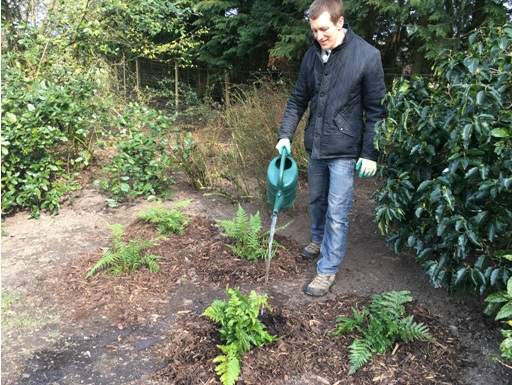
Pruning & Winter Protection
Pruning is very straight forward - simply cut away old, dead fronds using secateurs in late winter or early spring before the uncurling of new ones begins. This is more of a tidy-up exercise than a necessity because, if not undertaken, the old fronds will simply fall to the ground and biodegrade naturally. However, winter protection of half-hardy tree ferns is very important to avoid the fronds of your precious plant being lost to the frost. Place a generous layer of straw atop and around the crown, carefully tying up the fronds, then wrap both the tied fronds and trunk with several layers of garden fleece. A popular alternative in colder gardens is to lift your ferns or plant them in pots to allow them to be moved to an outbuilding, conservatory or greenhouse during the winter. Winter protection of other ferns is not normally required except during the harshest of frosts.
-
Plant Guides
- Guide to Bamboo Plants
- Guide to Climbing Plants
- Guide to Climbing Roses
- Guide to Conifers
- Guide to Floribunda Roses
- Guide to Fruit Bushes
- Guide to Fruit Trees
- Guide to Garden Ferns
- Guide to Garden Shrubs
- Guide to Heather Plants
- Guide to Hedging Plants
- Guide to Herb Plants
- Guide to Herbaceous Perennials
- Guide to Hybrid Tea Roses
- Guide to Japanese Maple Trees
- Guide to Ornamental Grasses
- Guide to Rhododendrons
- Guide to Topiary
Share this page:

